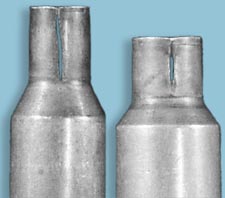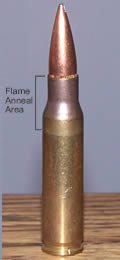- 01: Introduction
- 02: History
- 03: Propellants, Firearms, and Ammunition Development
- 04: Modern Firearms Manufacture
- 05: Small Arms Ammunition
- 06: Evidence Handling Procedures
- 07: Equipment and Instrumentation
- 08: Examination of Firearms
- 09: Cartridge and Shotshell Examination
- 10: Characterization and Evaluation of Fired Projectiles
- 11: Bullet Comparison and Identification
- 12: Gunshot Residue and Distance Determination
- 13: Toolmark Identification
- 14: Communicating Results
- Resources


Stress Relief, Annealing, and Hardness
Home > Small Arms Ammunition > Cartridge Case Manufacture > Stress Relief, Annealing, and Hardness

Split neck cartridge cases
Residual stress from the forming operations can affect both rimfire and centerfire cartridge cases. For many cases, especially those with bottlenecks, the stresses are so great that high-temperature annealing must be used.
After forming, a bottleneck case may appear perfectly serviceable. However, massive stresses are likely to remain in these areas. If the ammunition is loaded and stored without addressing these stresses, cracks can appear in the bottleneck area.

7.62 mm NATO cartidge
Click forlarger image
Case bottlenecks are normally flame-annealed by the following process:
- Placed on a moving rail or rotary disk system, the case passes before a set of gas burners that rapidly heat the neck and shoulder area to glowing.
- As the case becomes incandescent, the brass grains grow larger.
- The heated area of the case is immediately tipped into a water bath to quench the case, establishing the large grain size.
- The treatment causes a dark, but harmless, discoloration to the neck area. In commercial ammunition, this dark area may be polished out for cosmetic reasons; in U.S. military ammunition, the discoloration remains visible.
- The application of heat treatment technology to vary the grain size gradually, from small grains in the head area to large ones at the case mouth, determines case hardness.
All high pressure cases must have variable metallurgical properties depending on the part of the case, as follows:
- Head - must be tough and relatively unyielding, small brass grains contribute to the toughness.
- Body - the case walls must combine flexibility and strength to contribute to the obturation system.
- Mouth - must be softer (larger brass grains) to prevent cracks from the strain of holding a bullet.




